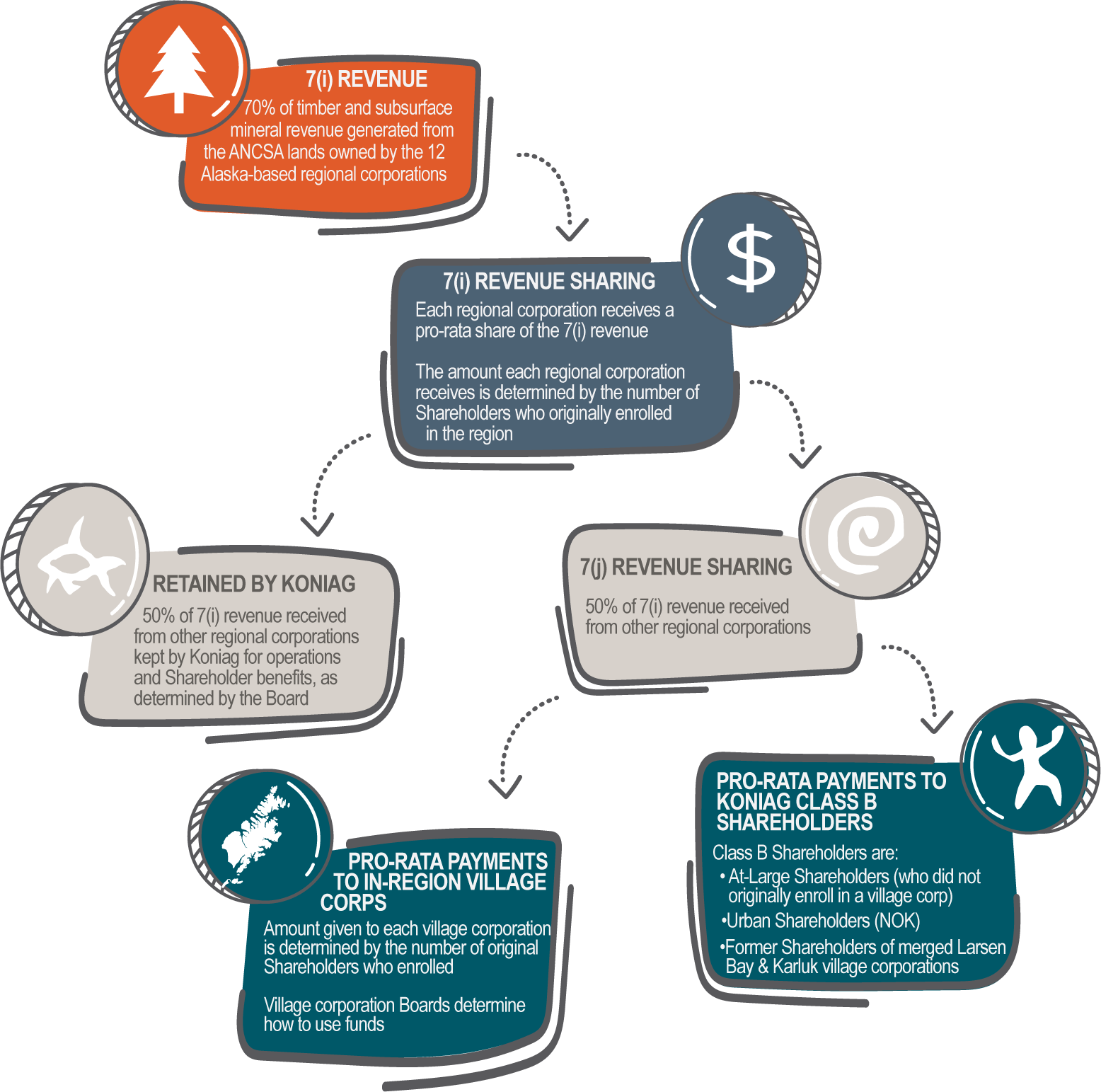ANCSA 7(i) Explained

Alaska Native Claims Settlement Act (ANCSA) Provisions – Sections 7(i) and 7(j) – Revenue Sharing
ANCSA has provisions for natural resource revenue sharing among the original 12 Alaska Native regional corporations. Koniag receives 7(i) revenue from shared earnings from the other regional corporations and shares half of these earnings per ANCSA Section 7(j) to class B Shareholders and to the village corporations within the Koniag region. Each village corporation determines how to use its 7(j) payments.
What is Section 7(i)?
The 7(i) provision of ANCSA requires the original 12 Alaska Native regional corporations share 70% of their net revenue from certain resource development on their ANCSA-conveyed lands with the other regions. The corporation that conducted the development keeps the remaining 30%. For instance, if Koniag harvested timber on its ANCSA lands, Koniag would pay 70% of the net revenues from the timber harvest to the other 11 regional corporations as well as paying itself Koniag’s proportionate share of 7(i). Koniag would keep the remaining 30%. (note: Koniag gets its proportional share of what it pays in 7(i). We pay ourselves our 7(i) share as does ASRC, NANA, etc.)
What is Section 7(j)?
In accordance with ANCSA Section 7(j), Koniag distributes 50% of the annual 7(i) funds received from other Alaska Native regional corporations to in-region village corporations and class B shareholders. These payments are referred to as “7(j) distributions” and are usually processed in June of each year. For Koniag shareholders who are enrolled in village corporations, Koniag issues 7(j) payments directly to village corporations in proportion to the number of original enrollees. It is up to the village corporations’ boards of directors to determine how they will use their 7(j) funds. Conversely, Class B Shareholders receive a proportionate payment directly from Koniag. Koniag must follow the law and make the distributions in this manner per Section 7(j) of ANCSA.
How much money does each regional corporation receive each year?
The percentage of 7(i) funds each regional corporation receives from other regional corporations is determined by the number of original Shareholders who enrolled in the corporation. The amount of 7(i) funds received each year changes, depending on the amount of revenue regional corporations made from certain natural resource development on their ANCSA lands. For instance, Koniag has harvested timber on our ANCSA lands in the past. When timber prices are up, Koniag makes more money off the timber we sell. This means that the amount of 7(i) Koniag pays to other regional corporations goes up.
How much money does each village corporation and class B shareholder receive each year?
The amount varies each year based on the natural resource revenues generated by respective regional corporations. Through Section 7(j) the amount each village corporation receives each year is proportional and determined by the number of Shareholders that originally enrolled in the village corporation. The dollar amount for class B shareholders is also proportional and Class B Shareholders receive their proportional share of 7(j) distributions directly from Koniag.
Who owns class A stock?
Class A stock was issued to Shareholders who enrolled in Koniag and also enrolled in a village corporation.
Who owns class B stock?
Class B stock was issued to Alaska Native shareholders who only enrolled in Koniag. These shareholders are commonly called “at-large” because they do not own shares in a village corporation.
Class B stock was also issued to Alaska Native shareholders who enrolled in the Natives of Kodiak, the only “urban corporation” in the Koniag region.
Natives enrolled to the village corporations of Karluk and Larsen Bay originally were issued Class A stock. Because Koniag merged with the village corporations for these two communities, the former shareholders of those two village corporations also received Class B stock in Koniag, in exchange for the stock they held in their village corporation. The former Shareholders of Karluk and Larsen Bay are now considered “at-large” Shareholders.
Who owns Class C stock?
Class C stock was issued to individuals who were not enrolled under ANCSA, but who were eligible on December 18, 1971, for enrollment to Koniag. These Shareholders have been referred to as the “Left-outs”.
